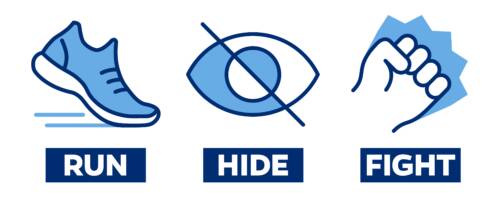Active Shooter
Active shooter incidents are threats faced by communities and school campuses across America. While the chances of an active shooter incident on our campuses remain low, knowing what to do if you find yourself in such a situation is imperative.
The University has produced a video to assist in these tense situations. While it is impossible to predict violent behavior, this informative video will provide you with essential information that can be easily recalled to protect yourself and others during an active shooter incident. You, as faculty, students, and staff, are the first line of defense. All of you are encouraged to review its content. In an active shooter situation, your survival may depend on how you respond. These situations are unpredictable and can escalate quickly. Staying calm and recalling the guidelines provided here is crucial.
Run, Hide, Fight

Many security organizations and law enforcement agencies worldwide endorse “Run, Hide, Fight” as a simple yet effective strategy for surviving an active shooter or similar life-threatening situations.
- Run: Find an escape route and escape the danger if you can.
- Hide: If running is impossible, seek cover and hide, or barricade yourself in a locked room from the shooter.
- Fight: As a last resort, fight back against the gunman to protect yourself and others. Remember that stopping the shooter is primarily the job of law enforcement.
This system provides clear guidance for responding during an active shooter incident, emphasizing self-preservation and quick decision-making. Always prioritize your safety and follow any specific instructions provided by authorities. Remember, silence your cell phone and call 9-1-1 when it is safe to do so.
If you have any questions, want to learn more about what to do in active shooter situations, or have safety concerns, contact Johns Hopkins Public Safety.
The safety of the Johns Hopkins community is of utmost importance. Through collaboration between many community stakeholders, including mental health care professionals (Behavioral Health Crisis Support Team | Public Safety, educators, parents, and law enforcement, and learning what to do in active shooter situations, we can all be better prepared to act.





